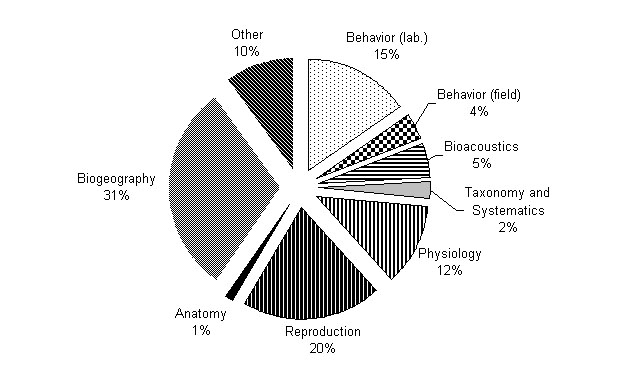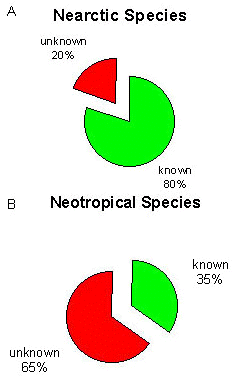
RT36: Hummingbird research perspectives
Thomas Zuechner1, Karl-L. Schuchmann1 & Steven M. Russell2
1Zoological Research Institute and Museum A. Koenig, Adenauerallee 160, D-53113 Bonn, Germany, e-mail
t.zuechner.zfmk@uni-bonn.de; 2University of Arizona, USA, e-mail smrussell@ccit.arizona.eduZuechner,T., Schuchmann, K-L. & Russell, S.M. 1998. Hummingbird research perspectives. In: Adams, N.J. & Slotow, R.H. (eds) Proc. 22 Int. Ornithol. Congr., Durban: 3226-3228. Johannesburg: BirdLife South Africa.
Hummingbirds belong to the most species-rich Neotropical bird family (c. 330 species). However, evolutionary patterns including all aspects of life history are poorly understood for the majority of taxa. During the Round Table Discussion, present knowledge was reviewed (Fig. 1, Fig. 2) and the following topics for further future research, with emphasis on Neotropical taxa, were discussed: (1) reproductive biology, (2) biogeography, systematics, and taxonomy and (3) establishing a comprehensive international reference database.
1. Reproductive biology
For approximately 60% of all Neotropical trochilids details of their reproduction are unknown (reproductive period, nest, incubation period, nestling period and ontogeny, onset of endothermy, etc.). These gaps of knowledge can best be filled with the assistance of local ornithologists and amateurs. During the Round Table Discussion the following guidelines were agreed on as a future basis of protocols for the comparison of intra- and interspecific reproductive parameters:
(i) display and vocal repertoire (e.g., notes/sketches of flight display, lekking behaviour, tape recordings of calls and/or song), (equipment: notebook, tape recorder, e.g. Sony professional tape recorder, directional microphone, e.g. Senheiser)
(ii) nest type, nesting site, and microhabitat choice (notes, sketches, photographic documentation), (equipment: notebook, good quality camera with close-up lens)
(iii) onset and duration of incubation (notes), (equipment: notebook)
(iv) egg size and egg mass (notes), (equipment: notebook, ruler, portable electronic balance)
(v) nestling ontogeny, morphology, growth (daily measurements of body mass at constant time intervals), and period (notes) (equipment: notebook, portable electronic balance, caliper)
(vi) natal care, female attentiveness, food items (notes), (equipment: notebook, binoculars, stop watch)
(vii) post-fledging observations on immatures (notes) (equipment: notebook, binoculars, stop watch).
Further investigation should include monitoring of individual birds, using colour marking, and/or bands (important: handling of hummingbirds often requires official permits of federal agencies).
2. Biogeography, Systematics, and Taxonomy
As a basis for phylogenetic and taxonomic studies it has been suggested to study distribution patterns of hummingbirds by the point mapping of individual records. These should be grouped according to geographical and orographical barriers (pools), allowing detailed analysis of geographical variation of morphological and morphometrical characters. Since such studies largely depend on scientific collections, museum-oriented research is a prerequisite. During the round table session it has been agreed to form a joint group of interested curators and students of major Neotropical collections to provide material for an ‘atlas of hummingbird speciation project’. The distributional data will be used to establish a Geographical Information System (GIS) serving as a basis for conservation-related problems. A research group addressing these issues will be organised by the first two authors (T.Z., K.-L. S.).
3. International reference database
The need for the accessibility of the international literature on trochilids was another addressed topic during the round table. Such a literature service will be provided by the first two authors in 1999. By then c. 5000 references dating back to 1840 will be accessible upon request. To complete the reference compilation special attention is given to locate contributions from local Latin American sources (e.g., unpublished research reports, newsletter-like releases).
A progress report on the addressed issues will be provided at the Neotropical Ornithological Congress in Monterrey, Mexico, in October 1999.
Fig. 1. Hummingbird research topics 1980 – 1997. Nineteen international ornithological journals scanned. Biogeography includes notes on range extensions.

Fig. 2. Present status of knowledge on (A) Nearctic and (B) Neotropical hummingbird species
